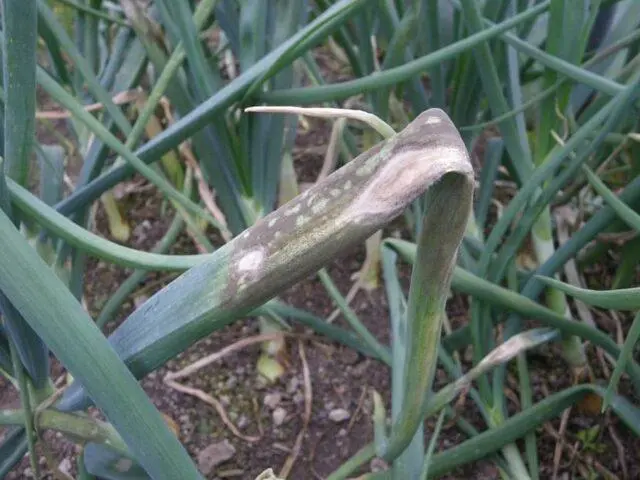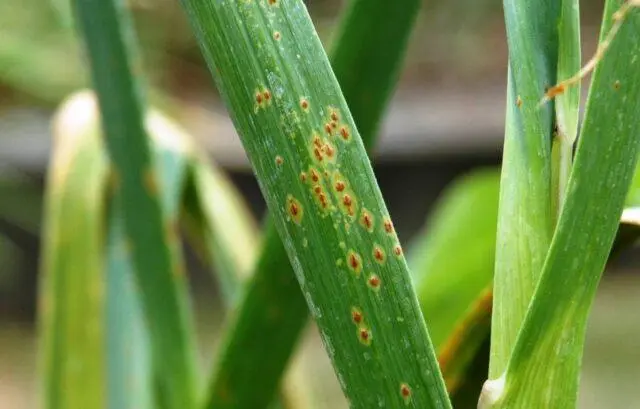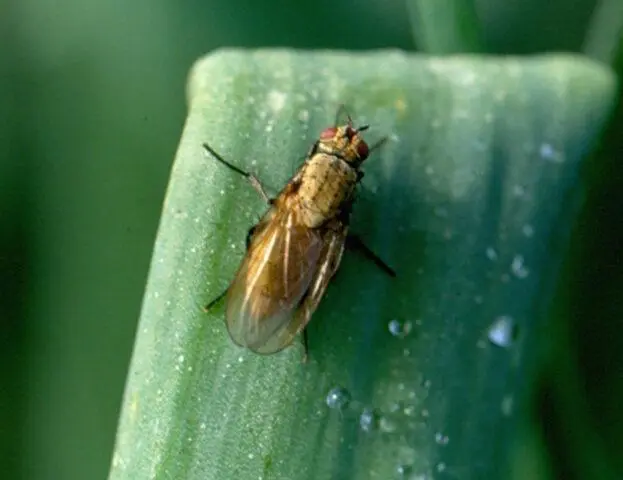Contents
There are several ways to plant red onions directly in the ground or in a home container. The culture is not too demanding for care, but certain rules must be followed.
Planting dates for red onions
It is customary to plant red, purple or blue onions in open ground in the spring, but the exact timing depends on the weather and the specific region. In the middle lane and in the Moscow region, the procedure is usually carried out in early May, when the soil finally warms up to 10-12 ° C.
In the south, planting red onions in open ground can be done in the second decade of April when the weather is right. In the northern regions, the dates often have to be postponed until mid-May due to the late onset of spring.
Soil Preparation
Planting red onions should be carried out in a sunny and well-ventilated area. Ideally, it is recommended to place the culture where legumes, nightshade, cabbage and spinach used to grow.
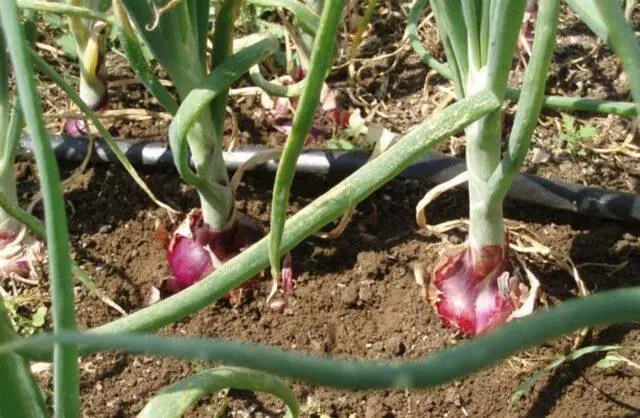
Undesirable predecessors for red onions are any other species of the same family.
The plant prefers loamy or sandy loamy soil, nutritious, but light. The acidity index should be 6,4-7,9 – red onions prefer neutral or slightly alkaline soil. A plot for planting a crop is prepared in the fall – they dig up the ground and remove weeds, add compost and humus, as well as phosphorus-potassium fertilizers.
Selection and preparation of planting material
For the successful cultivation of red onions, you must carefully consider the choice of material for planting. To obtain greens, take the smallest heads no more than 1 cm in diameter. They still will not turn into large bulbs, but they will be able to bring juicy feathers. On a turnip, specimens with a diameter of 1-2 cm are grown.
Preparing the material for use looks like this:
- Before planting, the delayed seedlings are sorted out and damaged or dried heads are sifted out.
- For 12 hours, red onions are heated at 40 ° C to prevent shooting. You can also simply soak the sevok for 15 minutes in water at about 50 ° C, and then transfer it to a cold liquid for the same period and dry it.
- The material is disinfected with a slightly pink solution of potassium permanganate for a quarter of an hour, and then briefly soaked in a stimulating preparation.
Similar procedures for red onions are carried out when planting seeds. At the final stage, it is also recommended to germinate the grains – for this they are wrapped in a damp cloth and cleaned in a warm place.
How to grow red onions
Planting red onions is carried out in several ways. You can use both sets and seeds – in both cases, the culture demonstrates good germination.
Planting red onion sets in spring in open ground
Planting sevkom allows you to get a plentiful, fairly fast and tasty crop of onion turnips. The algorithm looks like this:
- Planting material is sorted out and spoiled and overdried heads are thrown away.
- For the remaining small turnips, the upper parts are cut off by about 1/3.
- The bulbs are left to dry for 2-3 hours.
- On the prepared site in the garden, holes are made up to 3 cm deep at intervals of 15 cm.
- Sevok is planted in holes and covered with soil on top.
Between the rows of red onions, about 20 cm should be left so that the plants do not interfere with each other during the development process.

When planting red onion sets, the tops of the turnips are left above the ground
Sowing seeds in open ground
Red onions can be propagated by seeds, sowing them directly into the ground. Usually the method is used in the southern regions, where already in the middle of spring there are all conditions for planting a crop.
The scheme of sowing and growing is as follows:
- The site for planting red onions is prepared in the fall, and with the advent of spring they dig up and fertilize again.
- Garden crop seeds are disinfected in a solution of potassium permanganate and germinated in a damp cloth.
- The prepared material is planted in shallow furrows on the beds at intervals of 4-5 cm.
- Sprinkle the seeds on top with soil and moisten abundantly with a spray bottle.
At the initial stage, after planting the crop, it is recommended to cover the bed with a film to create greenhouse conditions. Remove it at the formation of the first shoots.
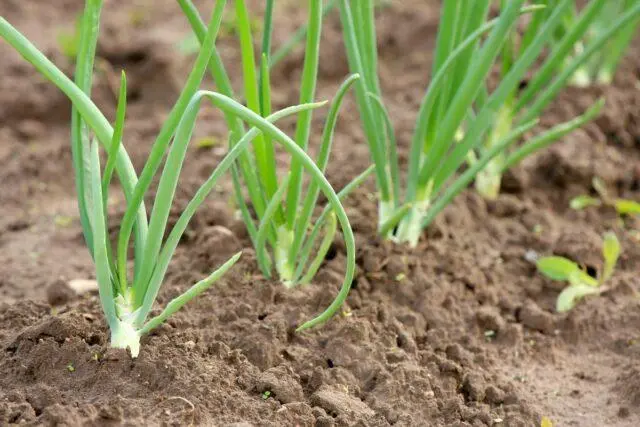
Red onion from seed germinates best at a temperature of 20-25 ° C
Growing seedlings in spring from seeds
With the late onset of spring, the culture is most often grown with seedlings, and with the advent of heat, strengthened seedlings are transferred to the ground. Planting red onions at home is done as follows:
- Seeds are sorted, disinfected and germinated.
- Fill shallow containers with nutrient soil with the addition of sand and humus.
- The seeds are laid out in shallow grooves at intervals of 2-5 cm.
- Sprinkle with soil and spray with a spray bottle.
- Before the emergence of seedlings put in a darkened but warm place under the film.
After the formation of green sprouts, the shelter is removed from the boxes and the seedlings are transferred to a well-lit room with a temperature of about 15 ° C. As the red onion develops, the seedlings are watered, and ten days before planting in open ground, they begin to harden in the fresh air. Seedlings are usually transferred to the garden in late April or early May. By the time of planting in the ground, the red onion should release at least three feathers.
Do they plant red onions before winter
Planting purple onion sets is recommended in the spring. In this case, underground turnips will definitely not die from frost, and the crop will give a bountiful harvest towards the end of summer.
At the same time, winter sowing is not prohibited. Cold-resistant varieties of red onions are suitable for planting in the fall. The procedure looks like this:
- The plot for the culture is dug up in advance and fertilized with humus and minerals.
- Wait until the soil temperature drops to 5 ° C.
- Furrows are made on the beds about 6 cm deep with a distance of 20 cm between rows.
- Seeds are planted at intervals of 8 cm, covered with soil and compacted.
The first watering for red onions is carried out only ten days after transfer to the ground. With the onset of frost, the site is mulched with straw and fallen leaves to protect against the cold. It is necessary to plant blue onions before winter with seeds according to the same algorithm.
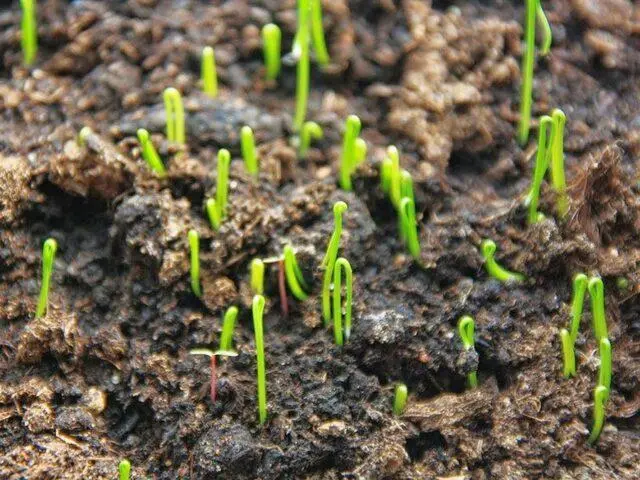
When planting before winter, about 25% of the seeds or heads of red onions may die
Features of care
Features of growing red onions from sets and seeds as a whole do not differ from the standard ones. The plant requires moderate moisture, periodic top dressing and control of soil looseness.
Watering
Red onions require regular watering throughout the growing season. In dry weather, it should be moistened twice a week, in the presence of natural precipitation – as the soil dries up.
If the crop is grown for cutting, then watering is carried out until autumn. When breeding red onions on a turnip, you need to stop moisturizing a month before harvesting. Otherwise, the underground heads will be small, watery and tasteless.
Loosening and weeding
After each watering of red onions, it is necessary to loosen the soil. The procedure provides good aeration for the roots. In addition, in the process, weeds can be removed, which robs the crop of moisture and nutrients.
Additional fertilizing
It is necessary to grow red onions with the periodic addition of nutrients to the soil. Top dressing is carried out several times per season:
- In the spring, organic fertilizers containing nitrogen are applied to the beds with onions. Best suited are bird droppings or mullein, diluted with water in a ratio of 1:10 or 1:5, respectively.
- During the formation of the bulbs, the culture is fed with phosphorus and potassium. Fertilizers are also diluted in a bucket of water, since they are absorbed better in liquid form and do not lead to chemical burns of underground turnips.
It is recommended to repeat top dressing for red onions after each cut of the feather, as the culture at this moment needs nutrients to recover. Leaves with regular application of organic matter are especially juicy and have a rich taste. But for the underground parts of any type of top dressing, they are only useful up to a certain point. Three weeks before harvesting turnips, fertilization is completely stopped.
Diseases and pests
Red onion due to the presence of phytoncides in its composition is relatively resistant to pests and fungi. Despite this, some diseases and insects can harm him:
- Peronosporosis. When infected with downy mildew, red onion leaves become covered with grayish or pale purple spots, and spore points become visible over time. Affected plants must be completely removed from the site so as not to infect neighboring specimens.

Protection against peronosporosis is provided by disinfection of soil, seeds and seedlings before planting
- Rust. Another fungal disease of red onions is manifested by orange spots and growths on green feathers. With a serious infection, the plant quickly stops developing and dies. Rust occurs most often when planting on waterlogged soil, the affected bulbs have to be removed from the garden.

After the destruction of infected plants, the remaining plantings must be sprayed with Bordeaux liquid.
- Onion fly. The pest lays its eggs on the plant, and after hatching, the voracious larvae eat away the underground parts of the garden crop from the inside. Red onions become unsuitable for food consumption, an unpleasant odor often begins to emanate from the beds. Infected plants can only be completely removed from the garden and healthy plantings treated with tobacco dust or ash solution.

It is usually impossible to save plants already affected by the onion fly.
Fungal diseases and pests are dangerous for red onions, mainly in violation of agricultural technology. If you process seedlings and seeds before planting, regularly loosen the soil and prevent waterlogging, the culture will develop and bear fruit without interference.
Harvesting and storage of crops
The ripening time of red onions depends on weather conditions and on the particular variety. But usually the culture reaches ripeness by mid-August or early September. You can understand that it is time to harvest the crop by the dried and fallen feathers of the plant.
Red onions are not immediately removed from the garden. First, it is simply lifted from the ground with a pitchfork or a shovel and the roots are cut. Then the bulbs are left to lie down in the garden for a week – during this time the turnips will dry slightly. A week later, the crop is harvested and cut off at the underground heads of the neck up to 10-15 cm and roots up to 5 cm. This allows you to increase the shelf life of red onions.
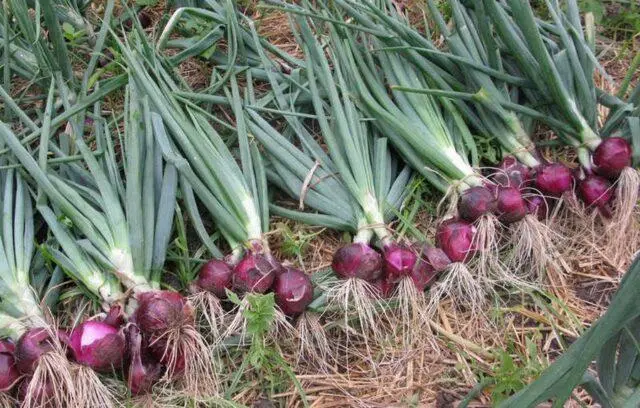
You can leave onions on the beds for drying only in warm weather without rain.
It is necessary to keep the crop in a dry room at a moderate temperature and good ventilation. It is allowed to store onions both in the cellar and in the attic, but it is important to protect them from light and not to place them close to heating appliances. Cardboard boxes, wicker baskets and dry wooden boxes are well suited as containers for turnips.
Valuable properties and taste of red onion usually retains for five months. For longer storage, it is better to freeze it at a negative temperature in a peeled and chopped form. In boxes and boxes of turnips, it is necessary from time to time to sort out and discard rotting specimens to preserve the rest of the crop.
Conclusion
You can plant red onions with seeds or sets, in open ground or in a home container. In all cases, it is necessary to carefully disinfect the plant material, and then provide seedlings with stable moisture, loosening and top dressing.










